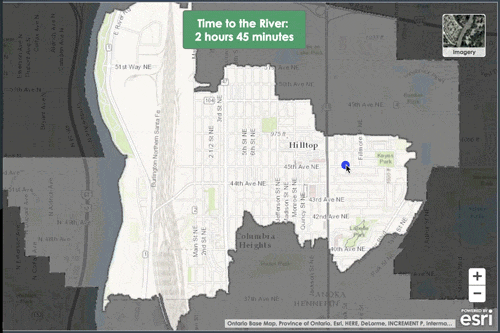News / December 20, 2016
New ‘Story Map’ Reveals the Hidden World Beneath Our Streets


One of my personal interests as a water resources engineer is finding ways to communicate about the highly technical work that I love in a way that an everyday citizen can understand. I have found that maps can often be an effective way to bridge this communication gap, and I have spent many long hours perfecting the translation of my engineering messages into beautiful, easy-to-understand maps and mapping applications.
So I guess it’s no surprise that the first time I saw ESRI’s new Story Map tool, I immediately started thinking about how we could use it at the MWMO. ESRI is the world’s leading maker of mapping technology (think the Microsoft of the mapping world) and their Story Maps combine interactive maps with text, photos, and other narrative elements to tell a geography-based story. (You can find some amazing examples of Story Maps in ESRI’s Story Map gallery.)
As it happens, the MWMO was already working on a project that seemed like a perfect candidate for a Story Map. Our watershed modeling initiative is designed to increase our understanding of our urban stormwater system through detailed computer models. One outcome of the project is that we can tell with precise detail how water drains from our urban landscape into the Mississippi River. We also know which areas of the land offer some treatment for stormwater runoff, and which don’t.

Using this data, we worked with Barr Engineering to create our own MWMO Story Map that tells the story of our hidden urban stormwater infrastructure. It includes photos and video from inside the tunnels and pipes that we monitor, and tells the tale of how rainwater makes it way off of the landscape, into the pipes and into the river in a northern portion of the MWMO’s watershed (covering portions of Columbia Heights, Fridley and Hilltop).
The highlight is an interactive map where the user can click on any point on the landscape and the path that rainwater takes to the river is traced out. (See the “From Your Front Yard to the River” tab.) The map also tells the user approximately how long it would take for water, from that location, to travel through the underground stormwater network and spill into the Mississippi River.
As an organization, one of the main messages for our outreach efforts is to remind people of their connection to the Mississippi River. This river (the third largest in the world) is a bit of a hidden gem in certain areas of the MWMO watershed, and people don’t always remember that the rain that drains off their property enters a storm drain at the end of the street and travels directly to the Mississippi River. In most cases, this water gets to the river untreated, meaning anything that happens to be in that water (pollution, trash, etc.) also goes directly into the river.
The intent of our Story Map is to help remind people of this connection and to give them some insight on just how close the river is to their front door. It’s a first-time effort for us, and we may return to it later to refine it or add new features as we receive feedback. So far, it has proven to be a useful outreach tool for our staff, but we’re excited to get your reaction too.
Let us know what you think! Drop me a line using my contact page.
Launch Story Map





